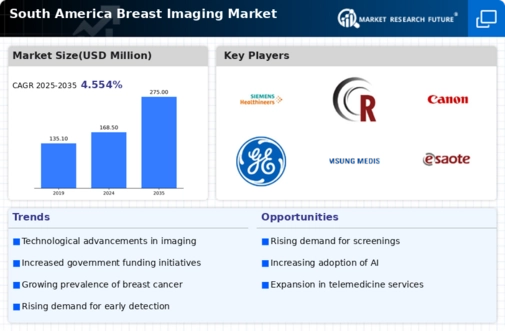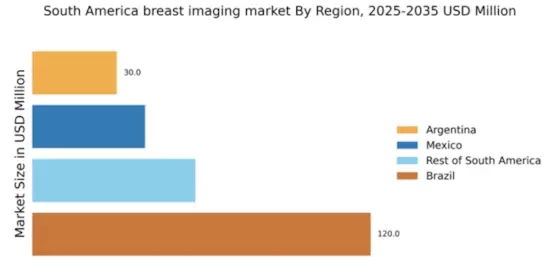Rising Health Insurance Coverage
Rising health insurance coverage in South America is emerging as a key driver for the breast imaging market. As more individuals gain access to health insurance, the financial barriers to obtaining imaging services are reduced. This trend is particularly relevant in countries where insurance penetration has been historically low. Increased coverage allows for more women to participate in regular screening programs, thereby promoting early detection of breast cancer. Consequently, the demand for breast imaging services is anticipated to rise, leading to market growth. Furthermore, insurance providers may begin to include advanced imaging technologies in their coverage plans, further incentivizing patients to seek necessary diagnostic services.
Growing Private Sector Investment
The growing private sector investment in healthcare is significantly impacting the breast imaging market in South America. Private healthcare providers are increasingly recognizing the importance of offering comprehensive breast imaging services to attract patients. This trend is reflected in the establishment of specialized breast clinics and the acquisition of advanced imaging equipment. The competitive landscape is evolving as private entities strive to differentiate themselves through superior diagnostic capabilities. Additionally, partnerships between private companies and technology firms are likely to foster innovation in imaging solutions. As a result, the breast imaging market is expected to benefit from enhanced service offerings and improved patient experiences.
Increasing Incidence of Breast Cancer
The rising incidence of breast cancer in South America is a critical driver for the breast imaging market. According to recent statistics, breast cancer accounts for approximately 25% of all cancer cases among women in the region. This alarming trend necessitates enhanced screening and diagnostic measures, thereby propelling the demand for advanced imaging technologies. The breast imaging market is likely to experience growth as healthcare providers seek to implement more effective screening programs. Furthermore, the increasing awareness of early detection's role in improving survival rates may lead to a higher uptake of imaging services. As a result, investments in state-of-the-art imaging equipment are expected to rise, fostering innovation and competition within the market.
Government Funding and Support Programs
Government funding and support programs play a pivotal role in shaping the breast imaging market in South America. Various initiatives aimed at improving cancer screening and treatment accessibility have been launched across the region. For instance, public health campaigns and subsidized screening programs are designed to encourage women to undergo regular imaging tests. This increased accessibility is expected to boost the utilization of breast imaging services, thereby driving market growth. Furthermore, government investments in healthcare infrastructure are likely to enhance the availability of advanced imaging technologies in underserved areas. As a result, the breast imaging market may witness a surge in demand as more women gain access to essential diagnostic services.
Technological Innovations in Imaging Techniques
Technological innovations are transforming the breast imaging market in South America. The introduction of advanced imaging modalities, such as 3D mammography and MRI, has significantly improved diagnostic accuracy. These technologies allow for better visualization of breast tissue, leading to earlier detection of abnormalities. The market is projected to grow as healthcare facilities adopt these cutting-edge solutions to enhance patient outcomes. Additionally, the integration of artificial intelligence in imaging analysis is expected to streamline workflows and reduce diagnostic errors. As a result, the demand for sophisticated imaging systems is likely to increase, driving market expansion and encouraging further research and development in the field.


















Leave a Comment